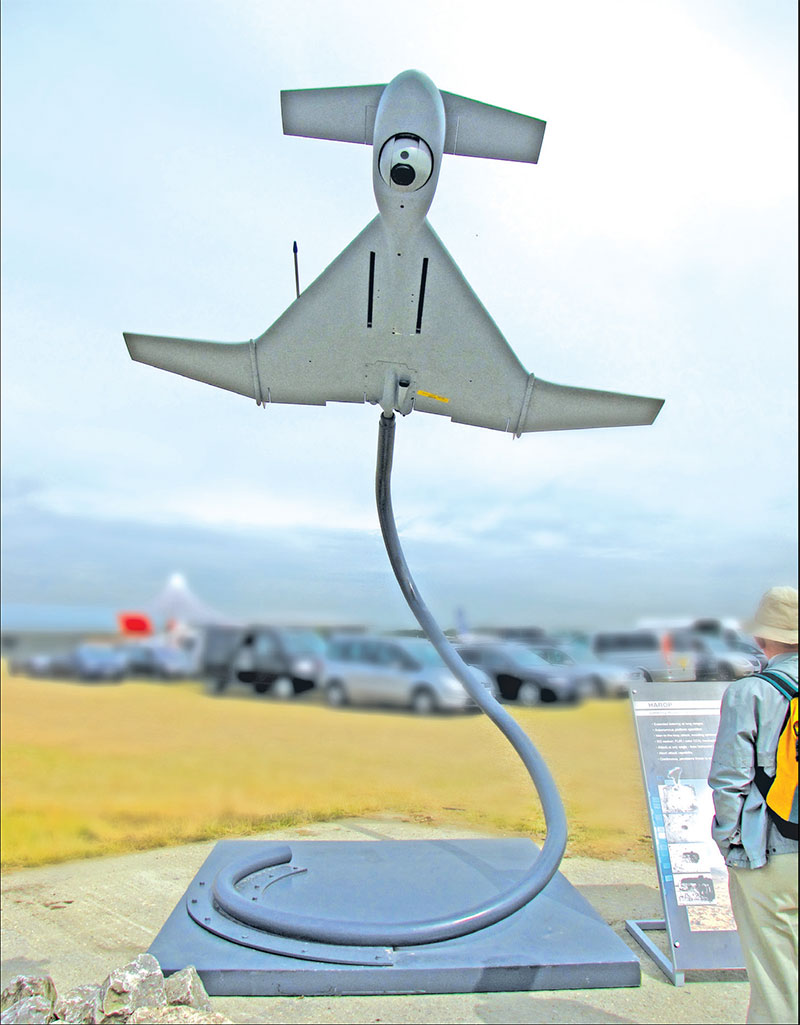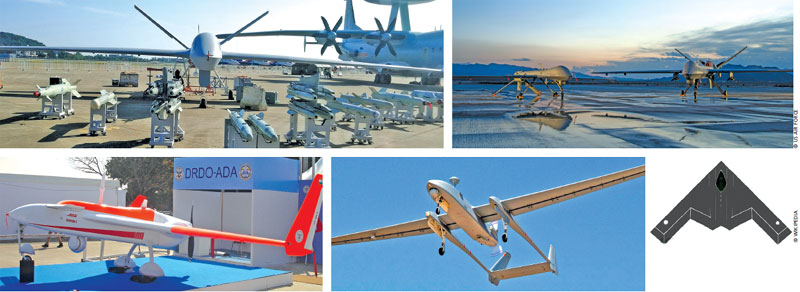Build an ecosystem in the country to produce the much-required UAVs and UCAVs
Smruti D

With the advent of technology in the defence sector, there is no doubt that the future is going to be unmanned. As security challenges are strewn across borders, intelligence has now gone beyond the human brain, bringing precision to every task it is employed for. While India itself employs UAVs for intelligence gathering, its neighbours, China and Pakistan, possess greater UAV capabilities. India’s border guarding forces suffer from menace that the Chinese drones cause by intruding into the territory on a regular basis, to either recce the Indian border areas or airdrop weapons and ammunition inside the Indian territory.
As India works hard to induct more UAVs into the system, by a way of the imports as well indigenous production, China has already secured its place as the second largest arms exporter after the US. The UAVs have played a key role in bringing this success to China. As per a research paper produced by the University of Pennsylvania and Texas A&M University, China has so far supplied armed drones to 11 countries. Apart from China investing heavily in the UAV-domain, India has another challenge to deal with—Pakistan is a loyal and almost regular buyer of Chinese drones. Hence, there is drone menace in India from both sides of the border. It is important to note that India does not have a single armed drone system inducted into any of the three forces but the process of acquiring these is underway. An advantage that these drones possess is that they can launch air-to-ground weapons without having to cross borders.
A report in the Hindustan Times stated that in December China sold 50 armed drones, the Wing Loong II to Pakistan. Announcing this, the Chinese state media said that the it would be a ‘nightmare for Indian ground formations in high-altitude areas as India’s military does not have the ability to new-age standoff weapons’.
The shift from conventional weapons to UAVs is evident now, as at the contested Ladakh border India had deployed the Israeli medium-altitude, long-endurance (MALE) Heron UAVs. All the Indian forces predominantly use the Herons, first procured in 1990 for surveillance and target acquisition. China, on the other hand, had test-flighted its newly developed AR500C unmanned helicopter in May. Chinese newspaper, the Global Times had reported that this UAV was capable of carrying out ‘fire strikes and disrupt electronic circuitry of its target at heights above 15,000 feet’.
Predator B Drones: As tensions with China soared in Ladakh, India made an emergency call for leasing two unarmed MQ-9B Sea Guardian UAVs from its ally, the US under the Defence Acquisition Procedure 2020. The Sea Guardian is a naval variant of the Predator family produced by General Atomics. The acquisition of predators has been a long-drawn saga. India had first shown interest in procuring the Guardians in 2017. The US approved of the sale of 22 of these drones to India in 2018. The number was later taken to 30. Later, as negotiations were on and reports surfaced of India willing to buy these UAVs, in June-July it was reported that India was rethinking of buying these UAVs because of its heavy costs. The deal is said to be more than USD3 billion. Ultimately, as the situation demanded, two Sea Guardian had to be leased from the US. In August, The Print reported that instead of acquiring a mix of 30 armed and unarmed drones, India was now planning to buy six armed drones. However, as of now, the deal paves its way slowly, with no concrete developments. The Hindustan Times had reported that while the Indian Navy is leading negotiations in this area, the army was in favour of the Predator B as they could be used by all three services, since the cost of the deal is high. The Predator B can carry up to 1.7 tonnes of add-on technology and weapons such as sensors, antitank missiles and guided bombs that weight more than 200 kg.
Heron and Mini Drones: In November, it was reported that the Indian Army would soon get Israeli Heron and American mini drones in order to better face the challenge posed by the Chinese forces in Eastern Ladakh. The acquisition of these drones is being done under emergency finance granted by the government to the defence forces. As per an ANI report, the small and mini American drones will be acquired for the troops at the battalion level. The Indian Army already has an existing fleet of Herons, the new ones will, however, have an advanced technology. Earlier in the year, as tensions heightened with China, it was reported that India would get its existing Herons upgraded. The upgrades would involve installation of satellite communication link. The ministry of defence (MoD) had been negotiating for arming these drones along with the upgradation.

Rustom: India’s own UCAV is under development with the Defence Research and Development Organisation (DRDO) for all the three services. The Rustom family include Rustom 1, Rustom H and Rustom 2. The Rustom 2 (MALE), it was reported in October that after the initial setbacks, the DRDO had flight tested the Rustom 2. It had achieved eight hours of flying at an altitude of 16,000 feet at Chitradurga, Karnataka. The prototype of this drone is expected to fly at a height of 26,000 feet and achieve 18 hours of flight. The latest reports claim that Rustom 2 will enter ‘full-fledged’ trials in the first half of 2021. This UAV can carry synthetic aperture radar, electronic intelligence systems and situational awareness systems.
Bharat Drones: In July, when the tensions between India and China refused to subside, DRDO provided the Indian Army with Bharat drones so they could help the army take on surveillance along the Line of Actual Control (LAC). These drones were small in size and equipped with Artificial Intelligence that helped them distinguish between friends and foes. While working in harsh and cold weather conditions, the drones were able to provide real-time video transmission.
Needless to say, India now has a growing appetite for UAVs. A few years ago, it was also reported that India was the fastest growing market when it comes to the UAVs. In 2016, India had finalised that in the coming 10 years, it would induct 5000 drones in the three services for USD3 billion. The tenders, the government had said, would be restricted to domestic companies, which could then tie up with foreign firms if they found it fit. Even as this was a promising development, four years later, nothing seems to have changed. The development of DRDO’s Rustom is underway. The Nishant UAV programme did not see success and was scrapped. India also had plans of inducting an unspecified number of HALE UAVs for the army.
Even as India currently struggles to induct the much-needed UAVs into the forces, the DRDO’s project named Autonomous Unmanned Research Aircraft (AURA) for the UCAVs may prove helpful to the forces, few years down the line. It is important to build an ecosystem for the production of UAVs and UCAVs within the country, especially now, when we are already behind time as compared to the neighbours. Mushrooming of start-ups and MSMEs in the defence sector that are interested in building UAVs could be the answer to the slow pace that indigenous manufacturing generally takes. Only, a little hand-holding may be required by the Indian government.

